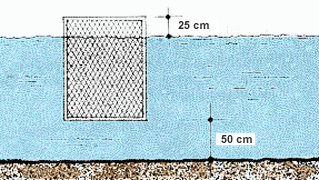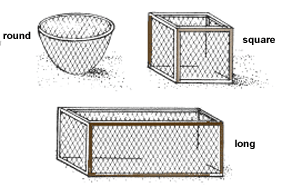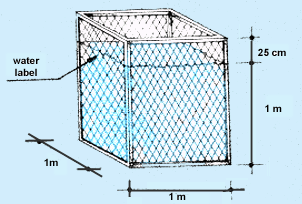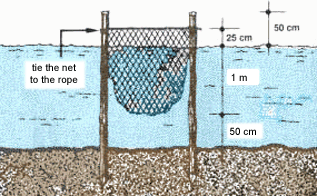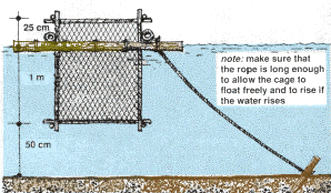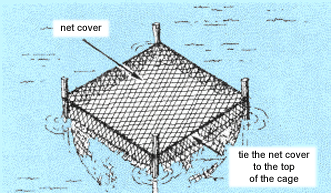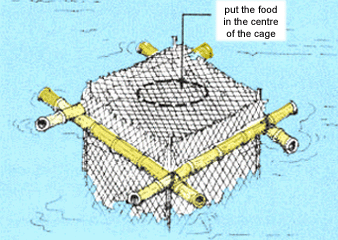16. PRODUCING FISH IN CAGES
LOCATING FISH CAGES(435) You can build a cage and put it in a stream, a river, a lake or a reservoir. You can also put it in a pond and it will help you produce more fish there. |
|
|
 |
 |
|
(436) The water should be deep enough so that when the cage is in place it will be at least 50 centimetres from the bottom. (437) A cage should be in a place where the flow of water is gentle and not fast. In addition, it should be protected from the wind. |
|
BUILDING A CAGE(438) A cage can be of any shape. It can be round, square or long. (439) A cage can be small or large depending on the number of fish that you want to raise. However, when you first begin, start by building a small cage. You will need fewer materials and it will be easier to take care of. |
(440) You can begin with a cage that has about 1 cubic metre (1 metre by 1 metre by 1 metre) of space for the fish. Later, when you have learned more, you can build bigger ones. |
|
|
|
|
(441) The best material to cover a cage is ordinary fish netting. If you cannot get fish netting, you can use either plastic mesh or woven material made from split bamboo or wooden strips. (443) However, if the openings are too small they may become filled with dirt. |
(442) The openings in the material that you use to cover a cage must be small enough to keep the smaller fish from getting out. | |
|
(444) Material with openings of 1.5 by 1.5 centimetres is suitable to keep in the smaller fish and also to let fresh water through.
|
(445) You can build a simple cage by driving four or more posts
into the bottom under the water and hanging a fish net inside.
|
|
(446) You can also build a simple cage by putting a square float
on the water and hanging a piece of fish net inside.
|
(447) If you want a better floating cage, you can build a frame with floats and close it with fish net, woven material or plastic mesh.
|
|
| (448) You can use either bamboo or wood for the posts, floats or frame. However, if you are using wood, choose a kind that does not rot quickly when it is in the water. |
BUILDING A SIMPLE POST CAGE(449) You can build a simple post cage using bamboo or wooden posts and fishing net. |
||
| (450) Find a place where the water is
at least 1.5 metres deep even during the dry season.
|
(451) Drive four posts into the bottom to form a square of 1.25 by 1.25 metres. The top of the posts should reach about 50 centimetres above the water.
|
|
(452) Tie a rope around the top of the posts to hold the fish net. The rope and the net should be at least 25 centimetres above the water.
|
(453) Hang a piece of fish net over the rope inside the posts and make sure that it is at least 1 metre under the water at the deepest part. (454) Tie the net to the rope all the way around the cage using strong cord.
|
BUILDING A SIMPLE FLOATING CAGE(455) You can build a simple floating cage using any wood that floats well, such as bamboo. It can be covered with fishing net, woven material or plastic mesh. (456) Tie four pieces of wood together using strong cord or rope to form a float 1 metre square. |
|
|
(457) Hang the float about 1.5 metres above the ground so you can work on it easily.
|
(458) Cut one long piece of material for the sides of the cage
and one square piece of material for the bottom.
|
|
(459) Depending on the material that you are going to use, tie or wire the long side piece around the outside of the cage. (460) Then tie or wire the square bottom piece to the lower edges of the sides in the same way. |
|
|
(461) If you have used fishing net or woven material, tie a length of rope to the bottom of each corner to be used to attach weights when the cage is in the water.
|
(462) Carefully put the cage into the water.
|
|
(463) Fix the cage firmly in place. Tie a piece of rope to one corner of the float and anchor the other end to a stake in the bottom.
|
(464) Now, if you have used fish net or woven material, tie a weight to the rope at each corner. The weight should not touch the bottom.
|
BUILDING A BETTER FLOATING CAGE(465) You can build a better floating cage by making a light frame of bamboo or straight pieces of wood cut from trees and covering it with either fishing net or plastic mesh. (466) Tie four pieces of wood together using strong cord or rope to make one side of the frame; it should be about 1 by 1.25 metres. |
|
|
(467) Now make another side of the frame the same as the first.
|
(468) Using four more pieces of wood, tie the two sides together 1 metre apart as shown below.
|
|
(469) Cut one long piece of material for the sides of the cage and one square piece of material for the bottom.
|
(470) Depending on the material that you are going to use, tie or wire the long side piece around the outside of the cage.
|
|
(471) Then turn the cage on its side and tie on the bottom piece in the same way.
|
(472) For floats you can use bamboo, banana stalks, wooden blocks or, if you can get them, plastic containers, pieces of polystyrene foam or used tyre inner tubes.
|
|
(473) Tie on the floats 25 centimetres below the top of the cage.
|
 |
|
|
 |
|
(474) Carefully put the cage into the water.
|
|
|
(475) Make sure that there is a depth of at least 50 centimetres of water below the cage, and tie the cage firmly in place. (476) To do this, tie a piece of rope to one corner of the float and anchor the other end to a stake in the bottom. (477) The cage should float so that 25 centimetres of it is above the water and 1 metre of it is below the water. Note: If the cage does not float 25 centimetres above the water, tie on more floats until it does. |
|
|
(478) You can build an even better floating cage like the one shown using pieces of squared, rough-cut wood. (479) This kind of cage can also be built with a door that can be locked and with a special opening for feeding the fish. (480) A locked door makes it more difficult for people to steal
your fish; however, you may need more floats for a cage with a
heavy wooden door.
|
|
PUTTING BABY FISH IN THE CAGE(481) When your cage is ready in the water you can put baby fish in it.
|
(482) If you are raising Nile tilapia you will need to put in 150 to 200 baby fish for each cubic metre of cage.
|
|
(483) After the fish are in you can cover the cage with a fishing net. This will protect your fish from fish-eating birds. To do this, stretch a piece of net over the top of the cage and tie it to the top rope. (484) When you feed the fish do not remove the cover; however, you may have to open part of the cover from time to time to take out any dead fish. |
|
FEEDING FISH IN CAGES(485) In a cage, there is usually very little natural food available to the fish, especially if you put the cage in a stream, lake or reservoir. (486) Movement of water may also carry the food you give to the fish out of the cage before the fish can eat it all.
|
(487) Feeding your fish well becomes very important when raising fish in cages. (488) Use rich food, for example cottonseed or groundnut cake and wheat or rice bran, mixed with fresh slaughterhouse wastes such as blood and rumen contents. |
|
|
(489) Mix dry food with some water to make it stick together in the form of a moist mash. (490) It is not easy to know exactly how much to feed your fish. You must watch them carefully to learn how much food they need. (491) Put the food for your fish near the centre of the cage
so that they can eat it before it floats away through the holes
in the sides. |
|
|
(492) Put in the food little by little so that you can watch the fish and see that they are eating. (493) If you see that the fish do not eat all of their food, give them a little less. |
(494) If you see that the fish eat all of their food quickly, give them a little more. (495) Remember that if you give your fish too much food it will collect on the bottom and make the water around the cage bad. |
|
|
(496) So, check under the cage. If you see too much uneaten food, you will know that you are feeding the fish too much. When this happens, move the cage to another place. |
|
|
|
(497) Follow the recommendations given earlier for ponds and pens:
|
TAKING CARE OF YOUR FISH IN A CAGE(498) You must always watch the fish to see that they are healthy and swimming strongly. (499) If the fish in your cage are not well, they will stop eating. |
(500) If his happens, stop feeding your fish for a day or two. (501) When you begin to feed them again, at first give them small amounts of food and then slowly more and more. When your fish begin to eat as before, you will know that they are well again. |
|
|
(502) If you find any dead fish floating in your cage, take them out right away. (503) Then, stop feeding your fish and watch them carefully for the next few days. (504) If no more fish die, you can begin to feed them after a day or two. (505) If fish continue to die, take them out as soon as you can and ask your extension agent or fishery officer for help. |
 |
TAKING CARE OF THE CAGE(506) A cage can easily be damaged. If this happens you may lose fish. It is very important to check the cage every day to be sure that there are no holes where your fish can get out. |
||
| (507) If you find any places where the fish can get out repair them right away. | (508) In addition, you must be sure that the openings in the cage material remain free of dirt and plants so that fresh water can flow into the cage. | |
|
(509) You can clean the material of a cage using a brush or a broom. However, do it very gently so that you do not damage the cage material.
|
(510) Also, do not forget to check for uneaten food on the bottom under the cage from time to time.
|
|
(511) If you have put your cage on posts in the water, make sure that the posts are firmly in place so that the cage cannot float away.
|
(512) If you have a floating cage, make sure that the floats are tied firmly to the cage and that the cage is firmly tied in place so that it cannot float away.
|
HARVESTING FISH IN CAGES(513) If you have used baby fish 8 to 10 centimetres long or weighing about 15 to 20 grams and have fed them well, they will be ready for harvesting in about five months. At this time the fish will weigh 100 to 150 grams each. (514) If you want to harvest only some of your fish, use a small handnet and collect what you want without moving the cage.
|
|
|
(515) If you want to harvest all of your fish and your cage is small enough, pull it into shallow water and begin to collect the fish using a small hand-net.
|
(516) When you have collected most of the fish, you can lift the cage out of the water and collect the rest.
|
|
(517) If your cage is too big to lift out of the water, pull it into shallow water as far as you can and collect the remaining fish. Note: If you do not need all of your fish, harvest only what you need and leave the rest in the cage. Fish can be left in a cage as long as you continue to feed them. |
|
STARTING AGAIN(518) After you have harvested your fish, clean and repair your cage as quickly as you can so that you can begin again. |
||
|
(519) You can hold the baby fish that you have caught in a small pen or in another cage for small fish until you have finished the cleaning and repairing. (520) When you are ready to begin again, put in 150 to 200 baby fish 8 to 10 centimetres long for each cubic metre of cage. However, be sure to choose the biggest and best baby fish to put back in your cage. |
|
Summary
YOU HAVE LEARNED HOW TO PRODUCE FISH IN CAGES
To locate your fish cages best, look for
- good water in a stream, river, lake, reservoir or pond
- deeper water: there should be at least 50 cm water below the cage
- gentle flow
- protection from strong winds
To begin, prefer small cages such as 1 x 1 x 1.2 m
Build simple cages with locally available materials:
- make post cages with 4 wooden posts and fencing material
- make simple cages hanging from a floating frame
- make better floating cages suspended from floats
- use woven material or netting with 1.5 cm openings
- anchor your floating cages securely
Stock your cages with 8 to 10 cm fish, 15 to 20 g each
To produce tilapias, stock each cage with 150 to 200 fish per cubic metre
Feed your fish well:
- feed at least once a day, at the same time
- provide rich food in the form of a moist mash
- check for uneaten food under the cages and adjust food ration accordingly
Maintain your cages in perfect condition:
- keep the openings clear to maintain good water flow
- watch for holes and repair promptly
Harvest your fish after 6 to 7 months:
- use a hand-net to take out part of the fish
- bring the floating cage to shallow water to harvest them all

